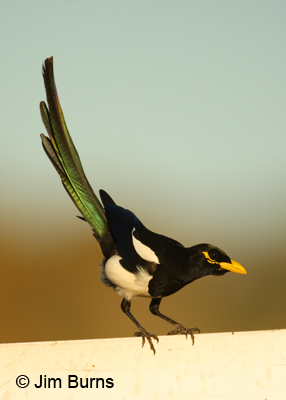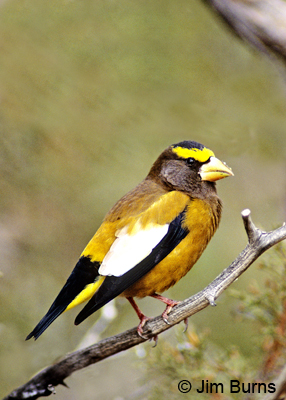|
Evening Grosbeak |
Every chain of thought and stream of consciousness in an idle mind can turn into a wildly convoluted trip, often scenic, sometimes scary. A recent one of mine evolved something like this--Christmas card time . . . I really don't relish this yearly exercise . . . Christmas is for kids . . . it brings guilt or sadness for me . . . I should have kept in better touch with those important enough to me to warrant a Christmas card . . . I send fewer and fewer cards each year . . . former friends have slipped out of my life . . . or passed away . . . gone extinct as it were . . . extinction is forever . . . we care only about the constants in our lives . . . we care for the rest after it's too late . . . like extinct species . . . many bird species in trouble . . . even birders don't care or think much about species outside their area . . . Yellow-billed Magpies . . . Evening Grosbeaks . . . .
This thought process journey ended with Yellow-billed Magpie and Evening Grosbeak, two beautiful and enigmatic species, because both were spotlighted in recent birding literature as declining for reasons not fully understood. The Yellow-billed Magpie, a close relative of the slightly larger, much more widespread American Magpie (formerly known as Black-bill Magpie) is endemic to the state of California. Even there it has been known historically only in the southern coastal ranges from the Bay Area south to Ventura and in the Sacramento and San Joaquin Valleys and their foothills.
Birds of North America describes Yellow-billed Magpie as "extraordinarily sedentary." Recent surveys taken indicate the population of this species has plummeted by half in the last twenty years. Originally some of this decline was attributed to housing development in its oak savannah habitat, but it is well known that the corvid family (jays and crows), to which the magpies belong, has been especially vulnerable to West Nile virus.
This is a very conspicuous, charismatic, long lived (up to ten years), monogamous but very social species that nests in loose colonies, famously defends territory against raptors and predatory mammals, and is known to practice "funeral" gatherings. In the morning sun, the contrast between yellow bill and facial skin and black and white body is stunning, and when the light is just right the bird's wonderful blue and green irridescences rival the colors of any warbler or hummingbird.
Evening Grosbeak, one of our largest finches, is another yellow, black, and white, boldly patterned species, popular at winter feeders in the northern tier of states. An inhabitant of coniferous forests across Canada, Evening Grosbeak underwent an extensive range expansion eastward in the late nineteenth and early twentieth century fueled by two things: the planting of box elder trees (their seeds were a new reliable winter food source); and the outbreak of spruce budworms (a favored prey item) in northern spruce forests.
Winter Evening Grosbeak flocks have always been unpredictable and nomadic wanderers given to large irruptions southward when breeding range food sources grew scarce in cold weather, but this species has largely disappeared from formerly visited winter areas in the northeast, and it is estimated that there has been an almost eighty percent decline in population. Although researchers cannot find definitive proof, the dropoff seems to have coincided with pesticide spraying programs successful in killing off spruce budworm infections.
A Project FeederWatch participant in Iowa recalls seeing hundreds of Evening Grosbeaks decorating their trees like yellow ornaments back in the 80s, and a FeederWatcher in Pennsylvania reported a few in 2007 for the first time in twenty years. This is a large, showy species which for years brightened up the harsh winter landscape over much of northeast and breeds locally in Arizona above the Mogollon Rim.
Magpie and grosbeak . . . special species worth caring about . . . reconnecting us to nature . . . bringing beauty and joy to a cold world in a cold season . . . bringing out the child in all of us . . . brightening our lives . . . the real purpose, after all, of this time of year . . . I guess I better get on those cards and renew old acquaintances: and maybe I'll sign up for Project Feeder Watch (www.feederwatch.org) or volunteer to do something at Audubon Arizona or one of our state parks to help bring the joy of birding to those who don't realize what's out there and how nature can refresh us and renew our souls.
